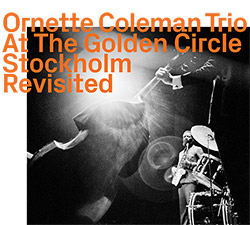
The ezz-thetics label issued two of Ornette Coleman's '60s albums prior to this one; the 2023 release Ornette at 12, Crisis To Man On The Moon Revisited features Impulse label recordings from 1968 and 1969, and the 2021 release New York Is Now & Love Call Revisited consists of two Blue Note albums recorded in April and May 1968. Moving further back in time, At The Golden Circle Stockholm Revisited comprises two live albums recorded on 3rd and 4th of December 1965 which were released separately on vinyl in 1966. The current release is the first time that those two live albums have been issued together on one disc. As their combined running time is just short of eighty minutes, there is no room for alternate takes, such as those on past Blue Note CD reissues.
Unlike the other sixties albums listed above and his earlier classic Atlantic recordings, which all featured a quartet or quintet with another horn (Don Cherry on trumpet and/or Dewey Redman on tenor sax) alongside Coleman, all the tracks on At The Golden Circle Stockholm Revisited feature Coleman as the lone horn in a trio with double bassist David Izenzon and drummer Charles Moffett. That trio had been together since late 1962. For financial reasons, they did not play many live gigs in 1963 and 1964, but in 1965 they did record three albums prior to Stockholm. Chappaqua was originally to be the soundtrack of a film of that name but was never used. An Evening With Ornette Coleman recorded a concert in Croydon, England, in August 1965, in which Coleman sometimes played trumpet or violin which he had taught himself to play. Recorded in Paris in November 1966, Who's Crazy was successfully used on the soundtrack of the film of that title.
From October 1965 onwards, the trio toured Europe and played gigs in Amsterdam, Berlin, Copenhagen, Lugano and Paris, culminating in two weeks in Stockholm. Having recently recorded albums and gigged together, by the time they were recorded at The Golden Circle the trio sounded as if they understood each other's playing and had been playing together for years. Crucially, while Coleman played saxophone on seven tracks, violin and trumpet on the other one "Snowflakes and Sunshine", he managed to convey a range of emotions, from excitement to melancholy. Izenzon and Moffett did not act as a typical jazz rhythm section, keeping time and playing occasional solos, but as parts of a three-way conversation which involved them all. So, when Coleman needs a breather, the bass and drums fill the space together, adding the occasional solo for good measure. The balance between the three musicians may in part be due to the quality of the sound on this album, compared to earlier releases of it; for that, credit must go to Michael Brändli who did the sound restoration and mastering for this release. This album has been a classic ever since its first release in 1966, but now it is better than ever before.
Comments and Feedback:



More Recent Reviews, Articles, and Interviews @ The Squid's Ear...


|

